The title of the new menu by Massimo Bottura at Osteria Francescana hasn't changed. It's still With a little help from my friends, but the Beatles, and the dishes inspired by their songs, have been replaced by something else. From the four artists from Liverpool, in Via Stella 22 in Modena, we've moved to 13 + 1, a total of 14, numbers that need to be explained. Bottura has indeed created a menu that is a tribute to Italian fine dining, to the colleagues that according to him have lightened up more than anyone else the scene in the past 60 years. And there's plenty of surprises to build this New Italian Tradition.
There have always been tributes, and there will always be. They have the greatest value among equally famous colleagues, as a sign of respect, or when honouring someone young, who haven't reached their apex, but you can already tell they have style, at least if you don't have preconceptions. They're often a lot of praise given by someone who is in fact only seeking some publicity with little interest.
The chef from Modena has done this other times too. In November 2017 he opened the menu at Francescana and, among the starters, one could find Omaggio a Ciro Oliva, Ciro Oliva from Naples, a fried savoury pastry with tomato sauce, cream of scamorza, anchovies, tomato and basil. Now, if we all think of this previous episode, but even without this reference, in Bottura's pantheon, only a pizzaiolo, and hence a pizza, is missing.
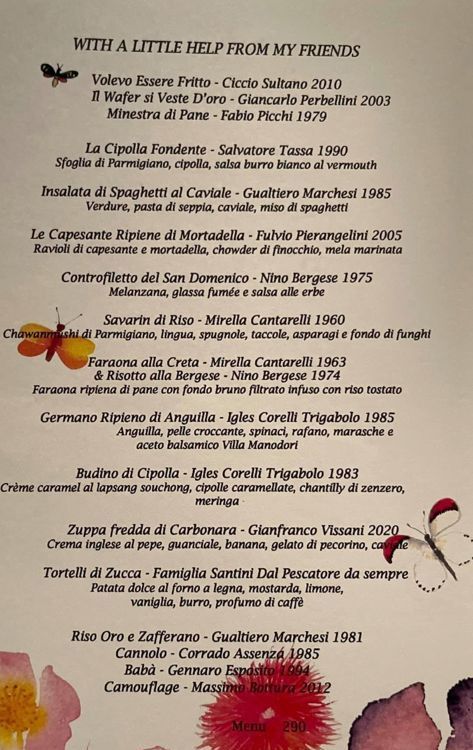
The new menu at Osteria Francescana in Modena
On the 23rd of June, Massimo launched the new menu and we had a chance to ask him the reasons behind it. There are many ways to compile a list, to reason one's choices. Eighteen dishes disassembled and reassembled, which from the photos that were shared on the days before the launch, one could tell they are interpreted by Bottura, re-imagined as if they were seen from many km above the surface of the earth. I don't even know how immediate it would be to connect them with the original version, without having the menu in front of you.
Eighteen dishes, though the number of chefs, female and male, is lower. The chefs are thirteen, fourteen counting the chef from Modena who kept the last act with Camouflage, whose very first version is from 2012. The very first step is with Ciccio Sultano who, we must recall, in 2006 signed with Massimo a book titled PRO. Attraverso tradizione & innovazione. Then there's Giancarlo Perbellini, Fabio Picchi, Salvatore Tassa, Gualtiero Marchesi, Fulvio Pierangelini, Nino Bergese, Mirella Cantarelli, to whom belong the eldest creations, Savarin di riso and Farona alla creta, both from 1963, Igles Corelli, Gianfranco Vissani, the Santini family and not just Nadia Santini, because their Tortelli di zucca belong to every generation, Corrado Assenza and, finally, Gennaro Esposito. A double choice for four of them: Marchesi, Bergese, Cantarelli and Corelli. And the host, I can reassure you after reading their names, was not influenced by personal preferences and dislikes. He focused on the dishes alone.
Paolo Marchi
Reviews by Annalisa Cavaleri, Marialuisa Iannuzzi, Carlo Passera, Niccolò Vecchia and Gabriele Zanatta.
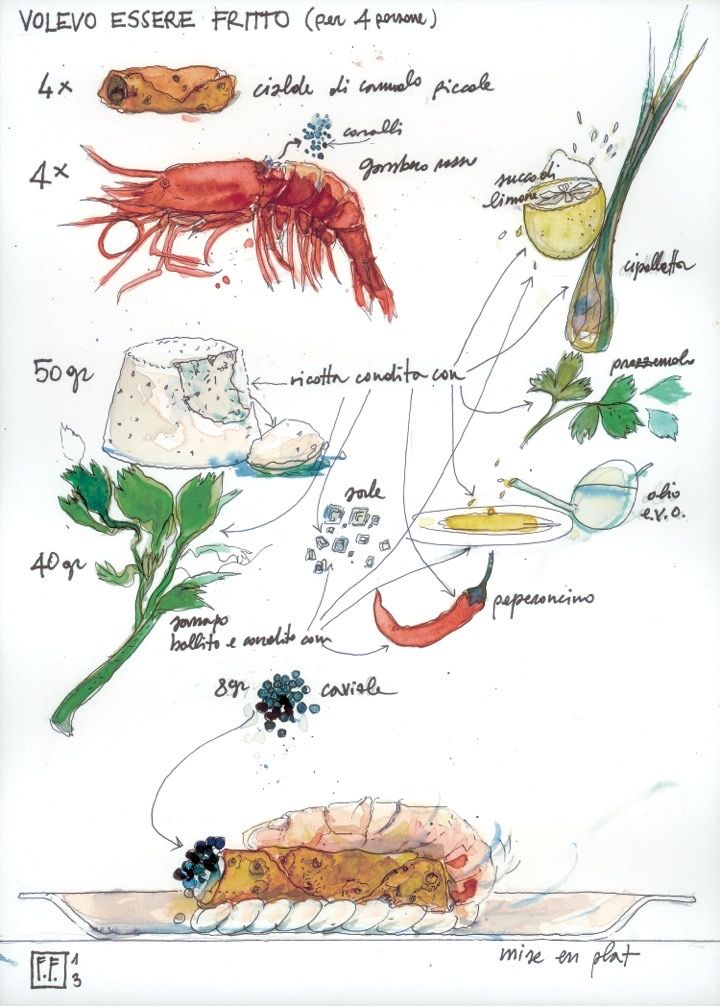
Volevo Essere Fritto illustrated by Fabrizio Foti
by
Ciccio Sultano – 2010
«It's the raw prawn that says "I wanted to be fried" – says chef
Ciccio Sultano – because, placed on a fried cannolo wafer, once you taste it, it seems it was fried too. In this recipe, the logic of layers enhances the contrast and prepares the final effect which is of an unsettling sweetness. It must be tasted the way you do with a traditional cannolo, letting the caviar melt in your mouth first – the caviar replacing the candied cherry. And then you eat the rest in a mouthful». In the recipe, the prawn tails are seasoned with oil and lemon, and then refrigerated. The heads are crushed to extract the corals, which are blended with lemon juice and chilli pepper. The cannoli are filled with ricotta, herbs and a few drops of coral sauce. The dish is finished with prawn tails and caviar.
Il Wafer si Veste D’oro by
Giancarlo Perbellini - 2003
«The
Wafer was born in 2003 as a crispy sesame biscuit assembled in different layers, like a wafer, putting goat's cheese and a seabass tartare in turns – chef
Giancarlo Perbellini explains – But I felt something, a spark was missing. After many attempts, I had the idea: liquorice. Since I didn't have any, I ran to a nearby pastry-shop and bought a Sperlari candy. I remember it as if it happened yesterday. That heart of liquorice, on the spoon, was the perfect pair with the
Wafer… That was the sparkle! In this dish, when you first bite it, you feel the liquorice, then the sesame, then the acidity of the goat's cheese and finally the delicate seabass tartare before you feel the liquorice again. Five neat flavours that keep coming back as if in an eternal circular reference».
Minestra di Pane by
Fabio Picchi - 1979
«For years I never made
Minestra di pane because I had a memory of what I believed was the very best one, the one made by
Luigi, the cook at trattoria
Antico Fattore – says chef
Fabio Picchi – Then one day
Luigi paid me a visit, he felt he had “no heirs” and so he told me the story and the secrets of that dish. I realised that with the bread that we made at the restaurant, that dish was even tastier than the one I remembered. This is why I decided to add it to the menu. The secret of the
Minestra di pane lies in the very Tuscan bread that we make artisanally with cereals from nitrogen-free fields, which has different nuances depending on the season, ranging from apricot to peach, from honey to propolis. The ear attracts the sun rays and absorbs the marine air». You first make a sauté in evo oil from the hills of Florence. «Then, when it becomes the colour of copper, you add some chopped garlic, a touch of chilli pepper, some rinds of prosciutto del Casentino, a sprig of pepolino, that is to say thyme, and three peeled tomatoes, possibly from Donoratico, which are very sweet. Then you add the vegetables: carrots, celery, leeks, savoy cabbage, potatoes, black cabbage, which must have suffered from the November cold. You simmer for some 3 hours and when the vegetables are soft, you can add the beans mushed with their cooking water, leaving some unbroken. Only then you add some stale bread from 2 or 3 days earlier».
La Cipolla Fondente by
Salvatore Tassa - 1990
«This dish was born in the middle of the hedonist culture that was typical of Italian cuisine – says
Salvatore Tassa, chef at
Colline Ciociare – My idea started from simplicity and homely memories, from the memories of the chargrilled onions my grandparents used to make: from that thought I later perfected my
Cipolla fondente. I remember that the first time I plated it, a waiter didn't want to serve it, he thought it was ugly: I forced him to do so and when he returned, he said the clients where thrilled. That's when I understood that that dish had a future, even though I didn't imagine it would be 30-years-long! The idea came from a childhood memory and then continued with my desire of offering a simple cuisine, which at the time was not fashionable at all: it took a little courage to do so».
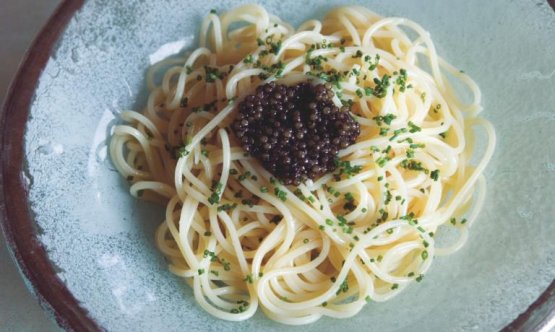
Insalata di Spaghetti al Caviale
by
Gualtiero Marchesi - 1985
Together with
Riso, oro e zafferano, also in
Bottura's menu, this is the most famous and celebrated dish by the maestro of Italian cuisine
Gualtiero Marchesi (1930-2017). A dish certainly brave and visionary, that brought dry pasta to fine dining, where it was considered as not good enough, and serving it cold too, paired with very few ingredients: shallot, chives, caviar. Perhaps it is for this reason too that
Marchesi, even many years later, considered it his most successful invention. To celebrate his 85th birthday, interviewed by
Carlo Passera on Identità Golose he said: «I believe that
Insalata di spaghetti al caviale is my utmost masterpiece. In this dish, the strongpoint is not the caviar, but the spaghetti! Just imagine I only realised this later».
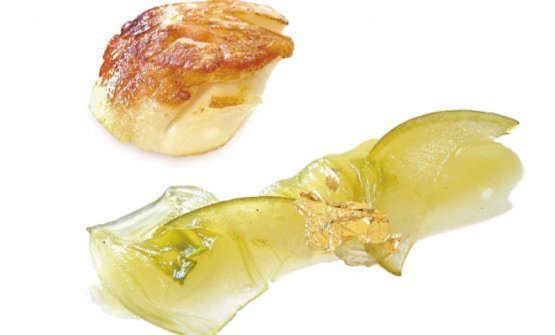
Scallops with mortadella, apples and fennel (first version, 2005). Photo by Bob Noto
by
Fulvio Pierangelini - 2005
This is one of the dishes in which chef
Fulvio Pierangelini shows the freedom of matching ingredients that are only seemingly in contrast and which in this case have the sea of San Vincenzo meet an assertion of meat. A dish which at his famous
Gambero Rosso in San Vincenzo, Livorno, changed each year, though some elements were unchanged: a cube of mortadella in the heart of a scallop, almost seasoning the mollusc with its sapidity, and, to pair with this, a purée of apple, thus freshness and acidity, balanced by the sweetness of the fennel.
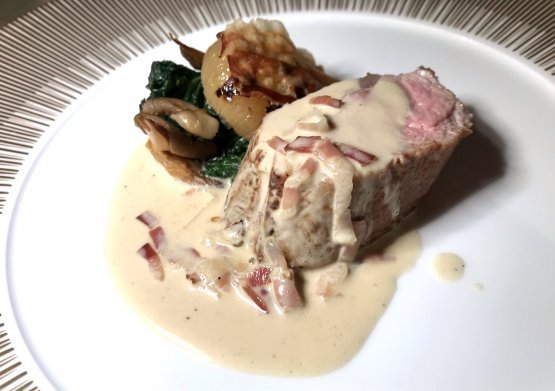
Controfiletto del San Domenico in the version presented by Max Mascia a Identità Milano
by
Nino Bergese - 1975
A historic dish by
Nino Bergese in Saluzzo (1904-1977), "cook of the kings and king of the cooks" who after being at the service of important families, in 1969 conquered two Michelin stars (when this was the top in Italy, there were no three stars yet) with his restaurant
La Santa in Genoa. He got the award again in 1975, when at the helm of
San Domenico in Imola, where they still preserve the gastronomic heritage.
Max Mascia, now at the helm of the restaurant in Imola, told us: «This dish has changed over time. Once it was made of sliced veal. These days we make it as a single portion. First, we cook it at low temperature, then we brown it at the end». Instead, the sauce is always the same: smoked jowl bacon which he fries with the veal chops, plus bay leaves and black pepper, and then a little vodka «for a dry glaze», and finally a cream of milk. «A classic Seventies' sauce».
Savarin di Riso by
Mirella Cantarelli - 1963
Mirella Cantarelli's (1927-1986)
Savarin di riso is a legendary delicacy from a legendary restaurant (we wrote about it recently here:
Storia e mito della trattoria Cantarelli, ossia di come Peppino e Mirella han influito sulla tavola contemporanea), that today we'd probably call it her signature dish. It was a miracle of harmony, inspired by French cuisine but reinterpreted by the great cook: a flan of Carnaroli rice, perfectly thickened in the style of Parma, and seasoned with a sauce of dried porcini from Borgotaro, covered in tongue in salmì and enriched, in the middle, with meatballs made with beef fillet (selected by her husband
Peppino with the usual care) minced with vegetables, Parmigiano, free range eggs, parsley and sausage (1 part of sausage for 3 parts of beef), before being rolled in breadcrumbs, and then fried and added to the porcini sauce.
Mirella explained: «It was born between 1960 and 1961. I got the idea from a magazine, and then I gradually changed it and fine-tuned it for my clients». Today we would say: a creative dish that puritans of tradition would despise.
Peppino would serve it with the home Lambrusco, with Grignolino or, when he had well assessed the guest, with a great French cru.
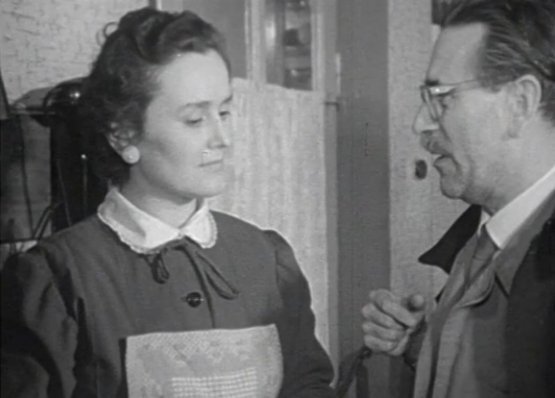
Mirella Cantarelli with Mario Soldati while filming Viaggio nella valle del Po
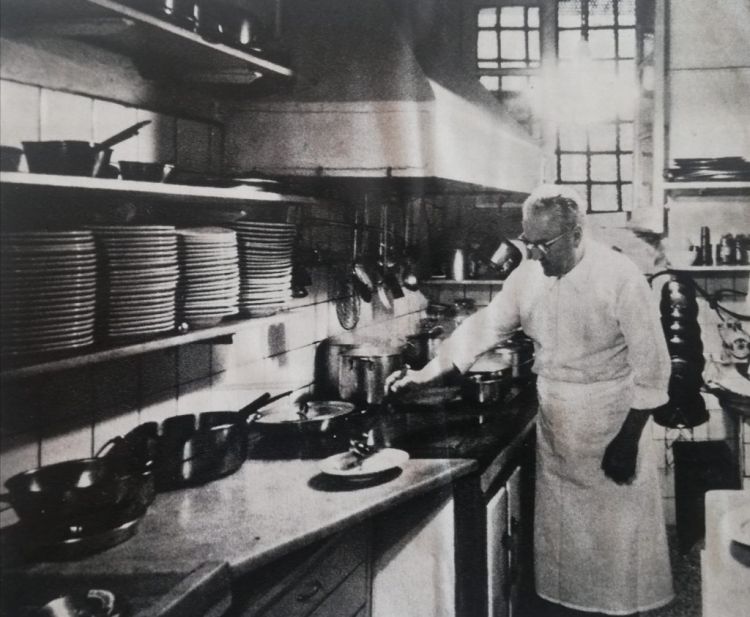
Nino Bergese in the kitchen of La Santa, in 1966, photo by William M. Zanca
by
Mirella Cantarelli - 1963
&
Risotto alla Bergese by
Nino Bergese - 1974
In only one
Botturian dish, two pillars of the great Italian cuisine between the Sixties and Seventies. The first: whether the menu said
Guinea Fowl in clay or
stuffed with artichokes or
with mushrooms, at
Trattoria Cantarelli it was always a celebration.
Mirella Cantarelli explained this dish to
Mario Soldati in front of the camera in 1958, for a TV show called
Viaggio nella valle del Po, the first food and wine report from Rai (
you can watch it here on Raiplay if you're in Italy): «I use rosemary, sage, juniper, a pinch of salt and spices, all inside the guinea fowl to give the "concia"». Then butter or oil and then everything goes in the «baking paper and then a little damp paper with bread and pasta». You tie with a string, wrap in clay and then bake in the oven for 4 to 5 hours. A dish to be booked in advanced and then enjoyed freshly baked,
Cantarelli pointed out, «it's good when you eat it freshly baked».
Bottura said the same: «Perhaps my
Non-roasted guinea fowl comes from
Mirella; there's the idea of a memory seen with a critical and not nostalgic perspective, there's a hint of France with the filling made with livers in the thigh, and with foie gras in the under-thigh and there's the sauces».
The myth also includes Risotto alla Bergese, named after its creator Nino Bergese. Risotto alla Bergese is one of his classics. It's a risotto “seasoned” with jus of veal and carefully creamed; this would give it unique, full flavours, with a clear French influence and this of course had to be the case for this chef who was the first in Italy to bring haute cuisine. This is what the great gastronomist Marco Guarnaschelli Gotti said: «I can still feel the texture of the rice and the magic velvety way in which each grain was creamed. The French call this onctuosité, but it's not oily at all».
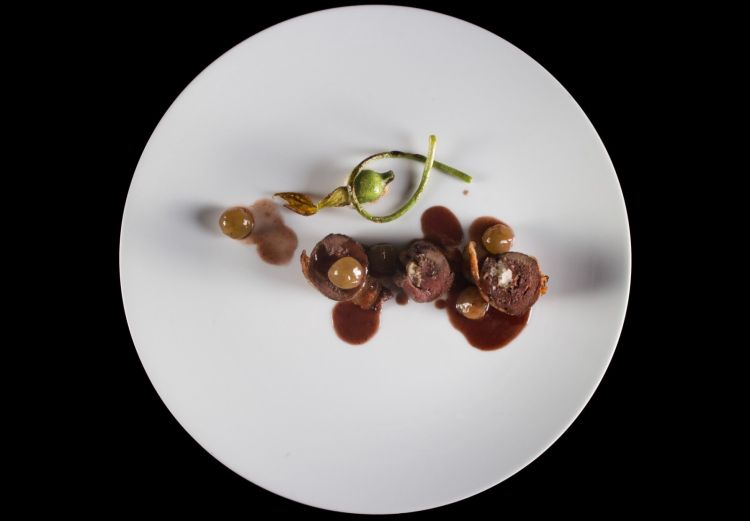
Germano Ripieno di Anguilla
by
Igles Corelli - 1985
The chef who with
Il Trigabolo, opened in his hometown Argenta (Ferrara), was a real pioneer of Italian fine dining, today presents this historic dish with these words: «The idea came from a memory of my grandfather, who was a fisherman and hunter, hence eel and duck where ingredients on my cards. I thought of matching them because they both gave me a gamey idea. I thought of duck stuffed with eel and then wrapped in a net of pork because I needed a ricker note. Then I thought of a sauce with blackberries and elderberries because ducks eat these fruits too. Finally, there were other ingredients finishing the dish, like a pumpkin flan. At the time it was a certainly daring choice, and indeed at first it was very hard to make people taste it. They were always in doubt when in front of that weird and innovative pairing. However,
Luigi Veronelli was among the first to try it and he was enthusiastic. So we insisted. We were convinced it was good and meaningful: after a couple of years it became popular and I serve it to this day...».
Budino di Cipolla by
Igles Corelli - 1983
«This dish has a fun history – says
Igles Corelli – and I believe it represents a border between the cuisine of the Eighties and avantgarde. The origin of the dish was venetian style liver, with totally different textures: there's an onion crème caramel, with a sauce of fat liver and different spices. In my life I participated in two competitions only, and with this I won the
Cipolla d’oro award in Sermide. I remember I arrived in this large room with the other cooks: some had made a
Torre degli asinelli all in butter, adding some onion tortelli around, some had made a
bocca di leone in ice with other things inside... I had this small
Ginori plate, with the pudding, the sauce, some fried leeks and some Sauternes for the pairing. The dining room manager came and asked me where I thought I was going with that dish, saying I should look at what the others had prepared instead. I was sure of myself because I had just made that pudding, it had balance, and those decorations, that I found slightly kitsch, I had made them when working on a ship. I knew they had to be made long in advance and so the flavours couldn't be really good. My dish won and when the manager came back he told me I surely had bribed the jury. It was at that time that we abandoned that type of cuisine for one that is much more innovative and for the history of
Trigabolo this was certainly one of the dishes that marked that process».
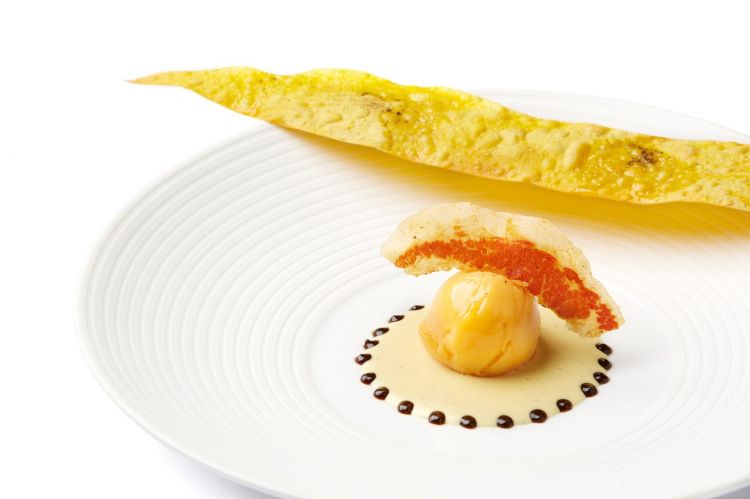
Zuppa fredda di Carbonara
by
Gianfranco Vissani - 2020
Carbonara is an impulsive dish, very strong on the palate, a first course full of personality which at
Vissani's evolves and becomes pure provocation. It's “the other side” of
Carbonara, a cuddle to finish the dish with a sweet and curious note. It's a custard made with eggs that follows all the rules of
Carbonara, but as a dessert: sugar replaces salt, which is concentrated in a pastry of crispy jowl bacon. It's finished with some aromatic coffee beans.
Tortelli di Zucca from the
Santinis, “since forever”
Is there a dish that marks more than others the quadrilateral in the Po Valley between Crema, Mantova, Ferrara and Parma? Perhaps not, and the merit goes to all the different takes on this timeless classic. The 5 “sweets” prepared at
Pescatore in Canneto by
Giovanni and
Nadia Santini are the result of a meticulous study on the proportion between pasta and filling. The latter encloses pumpkin from Mantua, breadcrumbs of amaretto, homemade mostarda senapata, Parmigiano Reggiano 24 months, nutmeg, cloves, cinnamon. A real dessert which was turned into a first course (and indeed
Massimo Bottura, given the mainly sweet character, leaves it almost at the end of his menu).
Riso oro e zafferano by
Gualtiero Marchesi - 1981
An emblem among emblems, from maestro
Gualtiero Marchesi (1930-2017), this risotto gives regal dignity to a traditional popular dish from Milan, by adding a square gold leaf in the middle, and by serving it on a plate with a black edge. Technically, «it's made the other way round», which surprised the cook. Indeed, instead of toasting the rice with onion and white wine, he cooked the onion with a little butter and some drops of white wine thus making a sour butter, a sort of
beurre blanc, which he kept to mix with the rice at the end, with a touch of Parmigiano. Marchesi would explain: «The rice is left to rest for 2 minutes, because cooking is always a violence on the ingredients». And then: «Gold is impalpable – he loved saying – but I'm sure it's good for rheumatism».
Cannolo by
Corrado Assenza - 1985
It is in 1985 that
Corrado Assenza gets at the helm of
Caffè Sicilia taking over from his master
Roberto Giusto.
Assenza's cannolo stands out for a few features: it has identity, it is minimalistic and dry. «The strongest challenge – he says – was to find the perfect alchemy between two elements: the wafer and the filling. The former, fried in lard, is crispy, light, friable and impalpable. The sheep's milk ricotta shows the fattiness, the aroma of milk and the gamey flavour. Which changes according to season, because sheep change location and hence diet. It's a masterpiece of shepherds, which translates in ricotta the mood of its territory».
Babà by
Gennaro Esposito - 1994
There are many babàs. But it's difficult to equal the goodness of the Neapolitan one with cream and wild strawberries that
Gennaro Esposito makes in Vico Equense, on the Sorrento Peninsula. It has a unique shape with 14 corners, for at least two people, it's made with brewer's yeast and rises twice, which is necessary so that the “sponge” returns to the initial position, even after it's immersed in rum. A perfectly balance play between power and sweetness, with the cream and the wild strawberries from Mount Faito doing the rest. It's the final centrepiece at
Torre del Saracino.
Camouflage by
Massimo Bottura - 2012
The only time he quoted himself is in this dish that ends
Massimo Bottura's the 2021 menu.
Camouflage, subtitle “The hare in the forest”, is a mimetic drawing that starts with
civet de lièvre, a Medieval recipe made famous by classic French cuisine. It was originally a stew, made by thickening the blood and bones of the hare on the fire. In the version made at
Francescana it's a metamorphosis from sapid to sweet that has acquired different shapes in time. The original one included an emulsion of civet sauce, foie gras, criollo chocolate, mousse of Italian-style espresso and sugar crystals. But the most intriguing effect is given by the powdered burnt herbs, the roots and spices that form a mimetic cover. This dish also inspired a magnificent video,
a visual ode signed by director
Andrea Marini.
Translated into English by Slawka G. Scarso